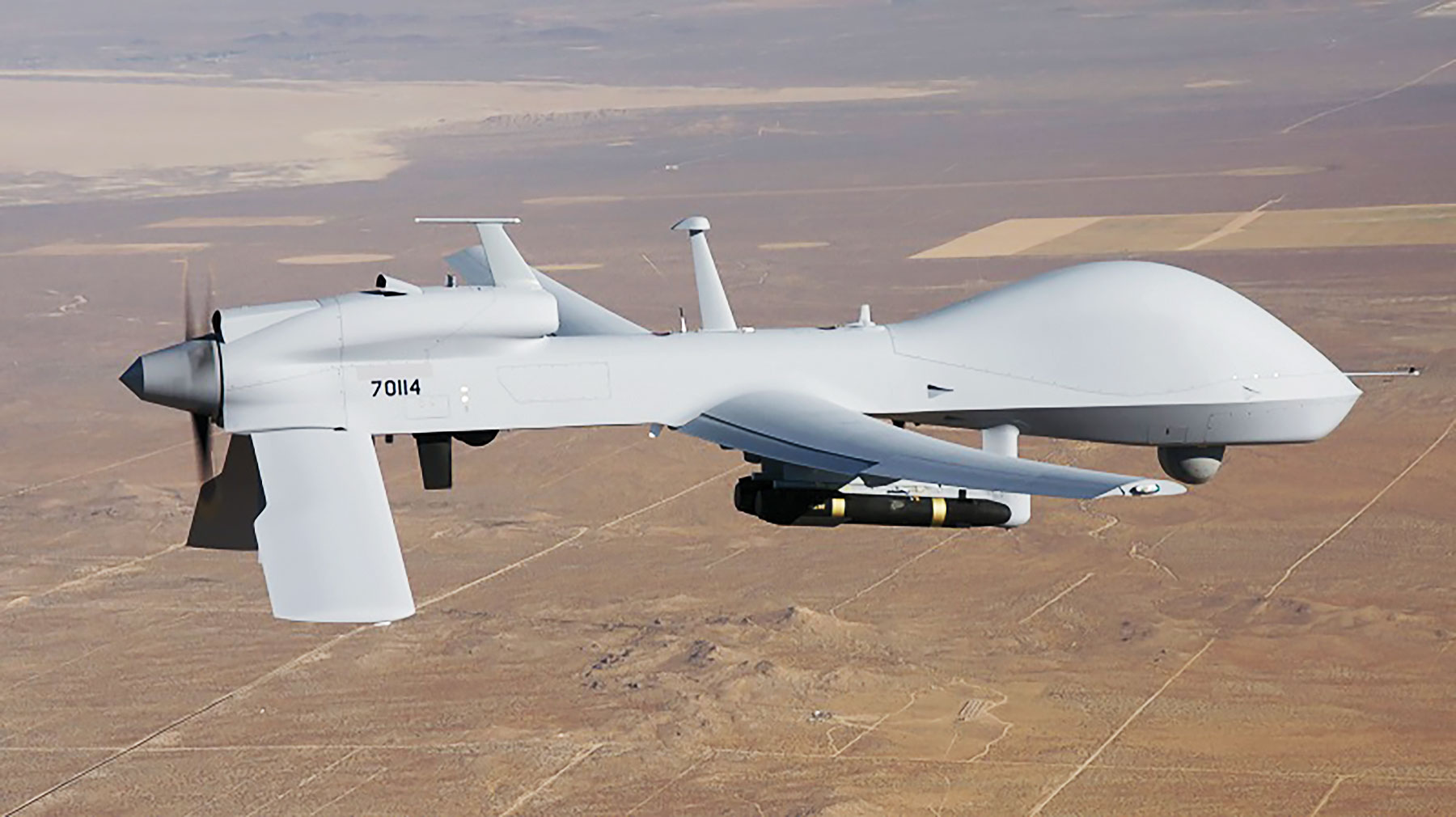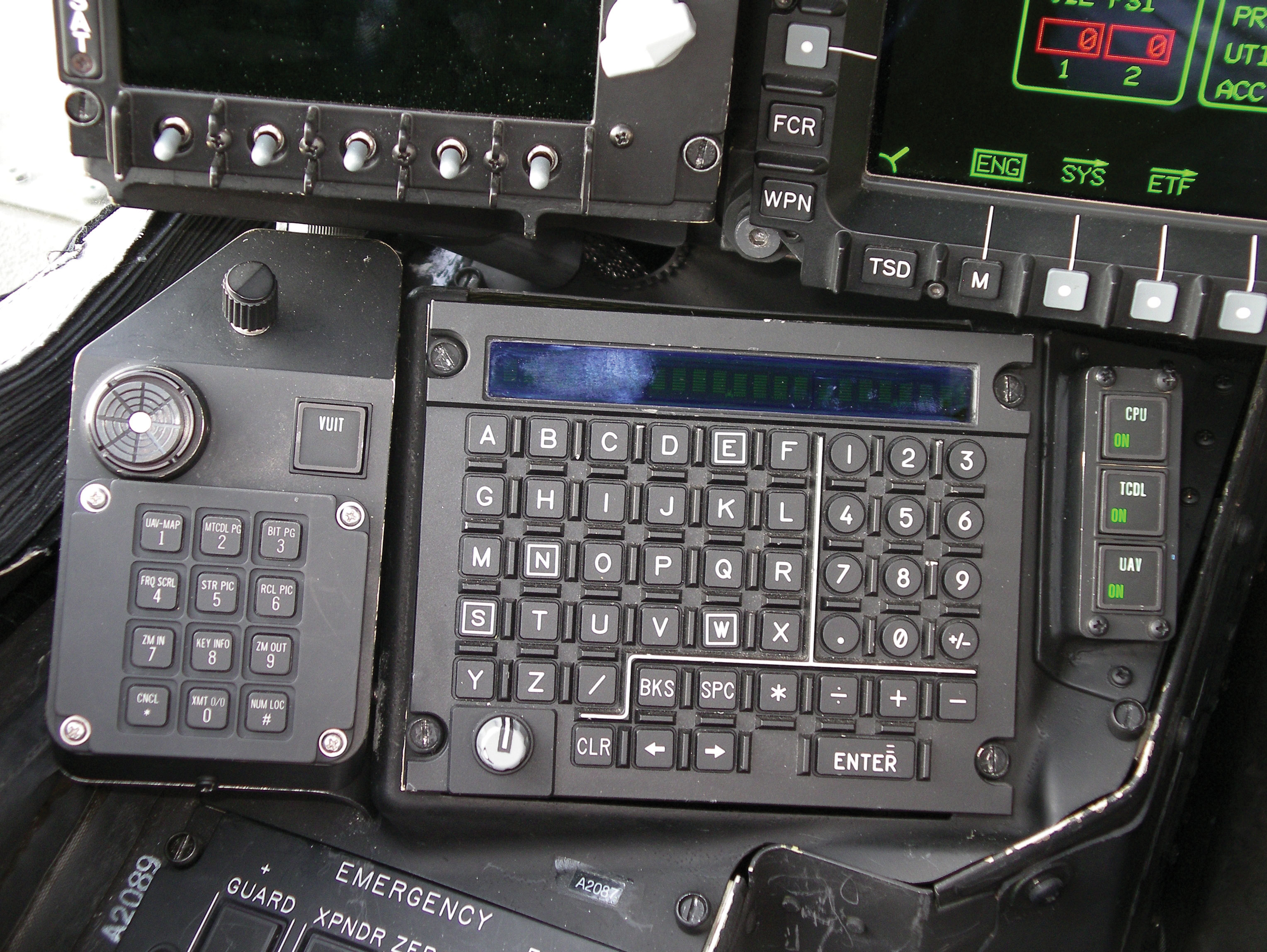
A drone directed by one or more Soldiers through uncontested skies is a thing of the past. Army aviation is developing collaborative and intelligent systems for manned and unmanned fleets in contested air-space.
by Mr. Kevin Kee
Future warfare will present challenges to Army aviation assets not seen since the contested airspace of World War II. Communication, navigation and command-and-control systems will be degraded and jammed, and aircraft will encounter air defense threats with new capabilities. While sobering, these challenges offer an opportunity to leverage autonomy and teaming in both manned and unmanned aircraft.
Army aviation uses a manned-unmanned teaming (MUM-T) capability first fielded in 2009. This capability provides full-motion vid-eo in an AH-64E Apache cockpit from an RQ-7 Shadow or MQ-1C Gray Eagle unmanned aircraft system (UAS). It also offers mul-tiple levels of control of the UAS, from the ability to view and control the electro-optic payload and laser designator to remotely con-trolling the vehicle’s flight. These systems allow the MUM-T operator to identify and fix the laser designator at targets, allowing HELLFIRE and other smart missiles to guide to and destroy the target. MUM-T is enabled by the Mini-Tactical Common Data Link, which transmits UAS or aircraft sensor video to a ground or airborne One System Remote Video Terminal. With this capabil-ity, UAS can provide reconnaissance, targeting and security to an Army brigade.

PICKUP AND DELIVERY
AMRDEC’s Aviation Development Directorate (ADD) conducts autonomous dual-lift operations with two RMAX UAS carrying a 20-pound payload through a set of hover and low-speed maneuvers at Moffett Federal Airfield, California, in September. The helicopters are an autonomous flight resource developed by ADD and have been used for numerous flight experiments since 2002. (U.S. Army photo)
MANNED PLATFORMS
The MUM-T link, while providing great operational benefit, has also introduced new challenges to the manned aircraft fleet. In the AH-64E, both the pilot and the gunner must balance the needs and requirements of flying the aircraft with the operation and control of the UAS over the MUM-T link. Much like driving while talking on a cellphone, multitasking limits the effectiveness of the capabil-ity.
To address these shortcomings, the U.S. Army Research, Development and Engineering Command (RDECOM) is increasing in-vestment in human machine interface (HMI) technologies to reduce MUM-T workload. A touch interface, voice commands, and a head-tracker that knows where the pilot or gunner is looking are promising technologies in this area.
RDECOM is expected to reach a major milestone in its Synergistic Manned Unmanned Intelligent Teaming program, which focuses on assessing new technologies in the areas of HMI, decision aiding and autonomy as well as new ways to employ those technologies. In 2019, RDECOM will demonstrate an air mission commander that uses one crew station to manage up to eight unmanned systems to execute scout, attack and air assault missions with less workload than is required to control one UAS today.
UNMANNED PLATFORMS
Current UAS platforms have served the Army well in counterinsurgency operations by offering a durable, relatively cost-effective plat-form with a sensor and, on the Gray Eagle, HELLFIRE missiles. In Iraq and Afghanistan, these unmanned platforms are able to cir-cle high above the battlespace, providing continuous information to the commander. In the future, however, such uncontested envi-ronments are likely to be the exception. Current UAS platforms require a runway for operations, and their limited airspeed means that they must be operated from many locations to provide the coverage required, requiring many more platforms and infrastructure to support operations.
The rise of UAS platforms has also led countries all over the world, including the U.S., to develop counter-UAS systems. These sys-tems vary but generally have the ability to jam or degrade data links and GPS signals, or to simply shoot down the UAS. Commercial UAS platforms have been hacked numerous times, degrading the platform, so this possibility must be considered for any existing or future Army UAS.
These factors are driving a need to develop new UAS platforms that balance endurance with greater speed and range. Most important is the ability for the UAS to operate independently of a runway, so that a division or brigade does not have to depend on a fixed air base. RDECOM is exploring these platform configurations and developing ways to increase survivability while driving down cost. The rapidly growing commercial industry offers new opportunities to team and leverage commercial advances.

Moving in the right
Direction
Current large UAS platforms like this Gray Eagle provide important capabilities but need a runway to take off. These systems also have lower airspeeds and depend on data links and GPS signals. Future systems will need to be more independent to operate in a complex battlespace. (Image courtesy of AMRDEC)
A NEW DOG IN THE FIGHT
The combination of new UAS designs and HMI technologies enables the next level of MUM-T capability: true teamed operations. Current MUM-T missions involve many Soldiers, including the pilot, the MUM-T controller and ground control station operators. All of these Soldiers must coordinate and hand over control of individual UAS platforms while coordinating with other aircraft on the mission. But the Army could take a lesson from game hunters to streamline this manpower-intensive process. Every game hunter knows the value of using a hunting dog or a bird dog to find prey or retrieve game, and this relationship between hunter and dog pro-vides a model for what true teaming should be.
The operational concept can be as simple as the pilot directing the UAS to provide reconnaissance of a particular area, so that the UAS—like the bird dog—would travel to the objective without continuous monitoring. A much more complicated MUM-T mission could involve multiple UAS platforms and manned platforms locating and tracking a target and then maneuvering to engage and de-stroy it.
This complex coordination of manned and unmanned platforms is enabled by RDECOM investment in airspace command-and-control systems that can translate a high-level group command—to scan an area, for example—into specific orders for each aircraft. Additionally, the system must have a self-healing capability to rapidly determine whether a UAS has to return to base or is destroyed and would, as a result, require a manned or unmanned platform to continue its task. These future MUM-T systems also would enable ground commanders to assign tasks directly to air platforms, demonstrating a new level of combined arms coordination.

CONTROLLING CONTROLS
Currently fielded teaming capability provides the crew of an AH-64E Apache with full-motion video and multiple levels for controlling a UAS while balancing the demands of flying the aircraft. (Image courtesy of AMRDEC)
AUTONOMOUS OPERATIONS
The ultimate goal of air systems is fully autonomous operation for all aviation mission sets. Already RDECOM has demonstrated an autonomous cargo delivery system called Autonomous Technologies for Unmanned Aerial Systems (ATUAS). In December 2011, it became the first aerial system to deliver cargo in theater, for the U.S. Marine Corps. Two aircraft deployed for a six-month demon-stration period that was extended to 2 1/2 years. RDECOM is building upon this success to explore autonomous operations for other aviation missions.
Fully autonomous operations are less vulnerable to data-link jamming since an autonomous vehicle can act on its own, given initial commands from an operator, and does not require constant updates. When fully realized as a swarm, this capability provides an op-erational benefit greater than what manned aviation could provide alone. These benefits come with the added challenge of platform complexity, however. Manned aircraft and human pilots have the ability to adapt to any condition on the battlefield, including system failures, changes in weather conditions and adjusting the mission based on new information. An autonomous or artificial intelligence pilot requires programming to exhibit these humanlike behaviors to provide the same flexibility. Additionally, starting in 2019, RDECOM will explore autonomous reconnaissance and target acquisition in complex environments where the enemy is hidden or camouflaged.
Any autonomous system has to interface with a Soldier at some point, and this is another technology focus. The automotive industry provides some examples and recommendations as it develops similar standards. Imagine, in the not-too-distant future, sitting in the driver’s seat of an autonomous car watching a movie and not having to pay attention to the road. If you were fully engrossed in the movie, it would be very difficult to take control of the car if the auto-steering system suddenly disengaged. You would need even more notice if you were traveling on curvy roads during icy weather. And how would such a system operate if the car were struck by light-ning? The Army needs to explore the same issues and develop systems that can degrade gracefully—slowing and landing an aircraft in a safe area, for example, as soon as the autopilot starts failing.
Current aircraft undergo block upgrades to modify hardware and software to improve performance and capability. The software of any weapon system is underpinned by system architectures, which are traditionally difficult to modify or upgrade. Much research is being done in this area, but for future air systems, what’s needed is development of open system architectures that are designed to make adding, upgrading and swapping components easy. For an autonomous system, the use of machine learning, the continuing pace of commercial and government research, and upgrades to the autonomy system from operations are going to stress the tradi-tional block upgrade scheme. Similar to smartphones, the autonomous UAS of the future will require the ability to securely update and obtain the latest security patches and algorithm updates.
Last—but most important for any autonomous system—is trust. Global investment in autonomy and artificial intelligence is massive and growing every year, and new technologies appear frequently. The specific technologies required to demonstrate an autonomous system are not completely understood yet, but it is likely that the algorithms will exhibit learning behavior.
For a Soldier to fully trust an autonomous system requires a thorough understanding of the system design and its behavior at any point. The operational requirement for the system, however, will require more flexibility and more humanlike behavior to truly pro-vide operational benefit. It is important to balance these two demands, both to ensure safety and to provide trust in the system.

RAVEN VISION
Staff Sgt. Justin Higginbotham, a U.S. Army Reserve Soldier from the 346th Military Police Company, launches an RQ-11 Raven at Fort Riley, Kansas, in October. The Raven increases operational visibility in austere environments, helping Soldiers see the battlespace from above. (U.S. Army Reserve photo by 1st Lt. Kirk Westwood)
CONCLUSION
Developing the future of collaborative and intelligent air systems involves continually balancing investment priorities in MUM-T and its enablers. Investment and innovation will occur throughout the joint community, industry and academia, and the Army must be ready to adjust investment in response to these external sources. Especially important is coordination in the DOD Autonomy and Air Platform Communities of Interest to leverage investments and share knowledge.
RDECOM has already had success in demonstrations of the ATUAS cargo delivery system and technologies that will lead to the field-ing of MUM-T. Over the next decade, the organization will build upon this success to develop and demonstrate new UAS platforms, autonomy and teaming technologies. This will culminate in a series of demonstrations to highlight the capability and its benefit to the Army. Overall, RDECOM’s focus in this area will ensure that the Army’s manned and unmanned aircraft are ready to overmatch any potential adversary.
For more information about AMRDEC, part of the RDECOM, go to https://www.amrdec.army.mil/ or contact usar-my.redstone.rdecom-amrdec.mbx.pao@mail.mil.
MR. KEVIN KEE is an aerospace engineer at AMRDEC at Redstone Arsenal, Alabama. He holds a B.S. in electrical engineering from the University of Alabama in Huntsville. He is Level III certified in engineering and is a member of the Army Acquisition Corps.
This article is published in the January – March 2018 issue of Army AL&T magazine.
Subscribe to Army AL&T News, the premier online news source for the Acquisition, Logistics, and Technology (AL&T) Workforce.







